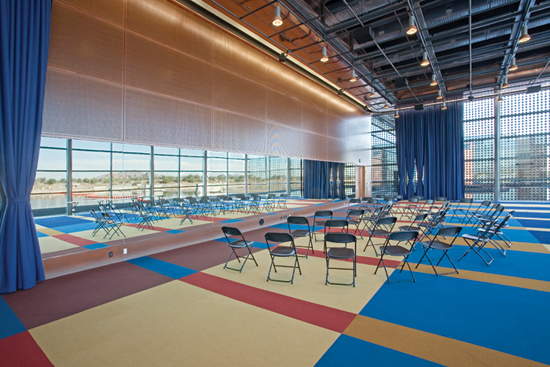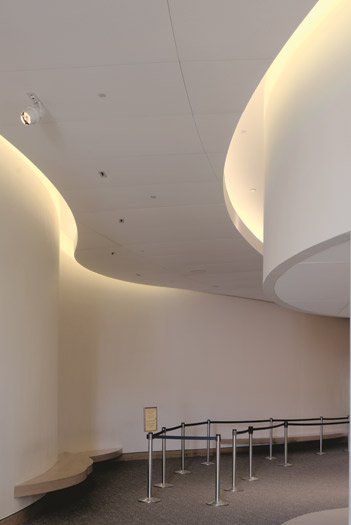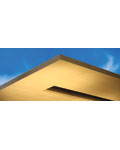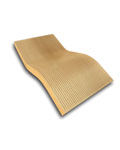Total Acoustical Design
Sound Attenuation: Limiting Unwanted Sound
In an ideal setting, the only sound that we would hear inside buildings and spaces would be the intentional, desirable ones. But, we all know that is not automatically true since unwanted sound or background noise can readily penetrate between rooms or between outside and inside. Such sound intrusion can create a lack of privacy or disrupt the normal activities of the space. This noise can originate from a variety of sources such as outdoor activity like transportation vehicles, or from indoor activity in adjacent spaces, or even from building mechanical and electrical systems. A certain amount of background noise is certainly commonplace and sometimes preferable depending on the setting. Excessive background noise however can seriously degrade the ability to understand speech, listen to music, or just communicate overall.
In order to limit or reduce the amount of noise entering or leaving a space, all components that enclose a space must be addressed. The goal is to control or attenuate the amount of sound passing through walls, ceilings, floors, etc. such that an acceptable level of background noise is achieved specific to the use of that space. Conversely it may be equally important to contain the sound in a given space so it does not spill out to other areas. Either way, there are some common and useful means to measure sound transfer and attenuation.
Transmission loss (TL) is a fundamental measurement of the ability of a material or building assembly to block or reduce sound. It is measured in decibels at different frequencies to determine how much sound transmission is lost at each measured frequency. Generally speaking, a TL of 10 means that the sound is 10 dB quieter on the listening side compared to the sound originating side.
Sound transmission class (STC) is determined by ASTM test methods to measure transmission loss specifically in interior walls. A higher STC rating (50 – 60 or above) means that more sound is blocked while a lower STC rating (35 or less) means that more sound is transmitted through. The STC number is derived from values tested at 16 different standard frequencies ranging from 125 Hz to 4,000 Hz. Acoustical engineers fit these values to the appropriate transmission loss curve to determine a final STC rating. The STC measurement is accurate for speech sounds but less so for amplified music, mechanical equipment noise, transportation noise or any sound with substantial low-frequency energy below 125 Hz.
Outdoor indoor transmission class (OITC) is a standard method used to rate the amount of transmission loss (TL) in an exterior wall setting such as determining how much traffic noise an exterior wall can stop. Compared to the STC rating, the OITC covers a lower or broader frequency range from 80 Hz to 4,000 Hz where most aircraft, rail, and vehicular traffic sounds would be found.
Ceiling attenuation class (CAC) is similar to an STC rating for walls, but is specific to suspended ceiling conditions where a dividing wall is constructed only to the ceiling height thus allowing sound to pass through a plenum space above the ceiling. As an ASTM tested measurement, it is a “two pass” test in that the sound is looked at as it transmits up through the ceiling in one space, across the ceiling plenum, and back down through the ceiling in an adjacent space. A higher CAC rating means that less sound is transferred between spaces. A ceiling system with a CAC below 25 is considered low performance, whereas one with CAC above 35 is high performance.
Impact insulation class (IIC) is a measure of the ability of a floor-ceiling assembly to absorb or deflect sound from impacts (such as people walking or objects dropping) and keep it from being transmitted to the space below. It is not a measure of airborne sound.
Noise criteria (NC) identifies the background sound level that a person experiences in a space. The NC criteria consist of a family of curves that define octave-band sound pressure levels within a building space corresponding to a chosen NC design goal. This measure is primarily applied to the sound pressure levels produced by a heating and air conditioning systems.
Sound Environment: Indoor Environmental Quality
Research has been conducted in a variety of university and clinical settings to determine the relative effects of noise on people in indoor environments. The findings have been convincing enough to determine that background noise can contribute to poorer performance in schools, longer patient recovery times in healthcare settings, and detrimental health effects to employees. This has led to the development of national standards such as ANSI Standard S12.60 “Acoustical Performance Criteria, Design Requirements and Guidelines for Schools” which establishes some very stringent thresholds for background noise. Specifically, for core learning spaces of 20,000 cubic feet or less, the one-hour steady-state background noise levels should not exceed 35 dB, while those over 20,000 cubic feet should not exceed 40 dB. This is the same low level of sound that one would experience in a quiet office. There is a caveat however that if the noisiest one-hour period during which learning activities take place is dominated by transportation noise, these maximum noise limits can each be increased by 5 dB. Within classrooms, ANSI S12.60 also identifies required RT limitations in order to maintain speech intelligibility.

Photo courtesy of Rulon International
Instructional spaces are particularly sensitive to good acoustics such that national standards have been developed for sound control in these settings.
ANSI S12.60 has also been recognized by the U.S. Green Building Council (USGBC) as a basis for performance in the LEED® for Schools Program with specific criteria in two cases. First, there is mandated prerequisite for minimum acoustic performance in the Indoor Environmental Quality (EQ) portion of LEED. The stated intent of this prerequisite is “To provide classrooms that are quiet so that teachers can speak to the class without straining their voices and students can effectively communicate with each other and the teacher.” There is also an additional IEQ credit for “Enhanced Acoustic Performance” with a stated intent “To provide classrooms that facilitate better teacher-to-student and student-to-student communications through effective acoustical design.” Beyond schools, LEED v.4 also includes criteria for hospitals and other settings to achieve improved acoustical performance. In order to achieve this enhanced level of performance, there are a number of strategies that can be undertaken.
Sound Design: Exterior and Interior Walls
Techniques for acoustical performance in exterior and interior walls center on increasing the transmission loss or in other words, reducing the sound energy that is transmitted through walls. In exterior walls that means increasing the OITC ratings while on interior walls it amounts to increasing the STC ratings. In both cases, the essential strategy is the same.
Most wall assemblies have cavities between structural framing members. If those cavities are left to contain only air, they do nothing to impede sound transfer in walls. However, if they are filled with a sound-absorbent material, such as acoustic batt insulation or similar products, then they can absorb sound waves that penetrate the cavity. The batts are either friction fit between framing or secured via a facing onto the structure. This approach provides basic noise control in a wall structure. When using single 2x4 wood studs (16 inches o.c.) and 1/2-inch Type X gypsum board, acoustic insulation can improve conventional wood stud walls up to an STC rating on the order of STC 34 – 36.

Photo courtesy of Owens Corning
Acoustically isolated walls and ceilings enhance sound quality, minimize background noise, increase the ability to concentrate, and improve speech intelligibility.
In order to obtain higher acoustical performance in walls, additional measures beyond batts are needed. A common approach is to separate the gypsum board or other wall facing material from the framing to help prevent the sound from transferring from one face to the other. This can be done by installing resilient channels or foam insulation over the studs before the wall facing is installed. There are also pre-manufactured engineered wood studs available that are split vertically and contain metal clips to keep the two sides of the wall isolated allowing sound vibrations to be isolated thus reducing transmission through the rest of the wall. Note that this type of wall framing has limited load-bearing capabilities and manufacturer's information should be consulted. Beyond this isolation of surfaces, it is appropriate to consider all of the gaps and openings that can exist around framing and other wall materials. Using an acoustical sealant will help fill those gaps and prevent sound from being transmitted through these spaces. Acoustic sealants commonly include silicone, latex, or acrylic-based formulations acoustically engineered to block sound with non-drying and non-hardening characteristics that allow it to retain its acoustic properties over time. Acoustic sealant is available for interior and exterior applications on a variety of different surfaces including gaps between wall stud plates and subfloor, openings around electrical outlets and boxes, air ducts and boots, doors, windows and other wall and floor penetrations or gaps. Sealant can contribute to a reduction in perceived noise levels through the walls on the order of 2 to 3 dB which is significant when compared with uninsulated, conventional wood stud walls.
Notice

www.ceilingsplus.com

OCBuildingSpec.com

rulonco.com









